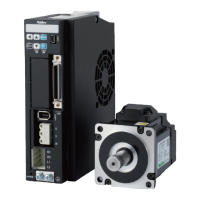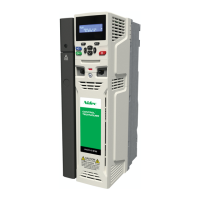22
8. Troubleshooting
Digitax SF Instruction Manual
4. Troubleshooting
Problem 5(Positional disturbance)
Cause Remedy
The command signal has
electrical noise present.
In Position Control/Pulse Train Command
Set Pulse train command Input lter (33.0) to an appropriate value.
Check the following three items.
1.
Status No.33 (Pulse Train Command Input (position) agrees with the host
controller output.
2.
Status No.65 “Position command” and Status No.67 “Position feedback”
agree.
3.
(Status No.67) x (Encoder pulse ratio (276.0/278.0) = (Position feedback
from the host control device)
If the above do not solve the problem, take countermeasures for noise.
Connect Ground/Earth FG correctly.
Adjust Pulse train command: Input lter (33.0)
Select a shielded twist-pair wire for the I/O cable.
For the encoder cable, select a shielded twisted-pair wire of no longer than
20m.
The position error is not
converging.
Verify that Status No.65 (Position command value) and Status No.67 (Position
feedback) agree.
If not, adjust the tuning parameters.
The host controller is not obtaining
encoder Z-phase correctly.
Check the command from the host controller.
Use Digitax SF Connect to measure the waveforms of Status No.33 “Pulse
Train Command
Input (position)” or Status No.49 “Analog Velocity Command
Input” to verify that a normal command is input.
Verify that the host controller is obtaining Z-phase correctly. If the Z-phase
pulse width is too small, increase the pulse width by using the Encoder pulse
ratio (276.0/278.0) As a rule of thumb, a pulse width of 1 ms or above is
required for PLC.
Output pulse frequency of the host
controller is above the upper limit.
Verify that the output pulse frequency of the host controller such as PLC is
not above the upper limit.
A resistor is installed in the pulse
output circuit of the host controller
(PLC).
Verify that there is no built-in resistor in the pulse output terminal.
The output resistor of the host controller and the input resistor of servo
drive being connected in series prevents correct command signal from
being input to the drive.
The motor does rotate, but position disturbance occurs.

